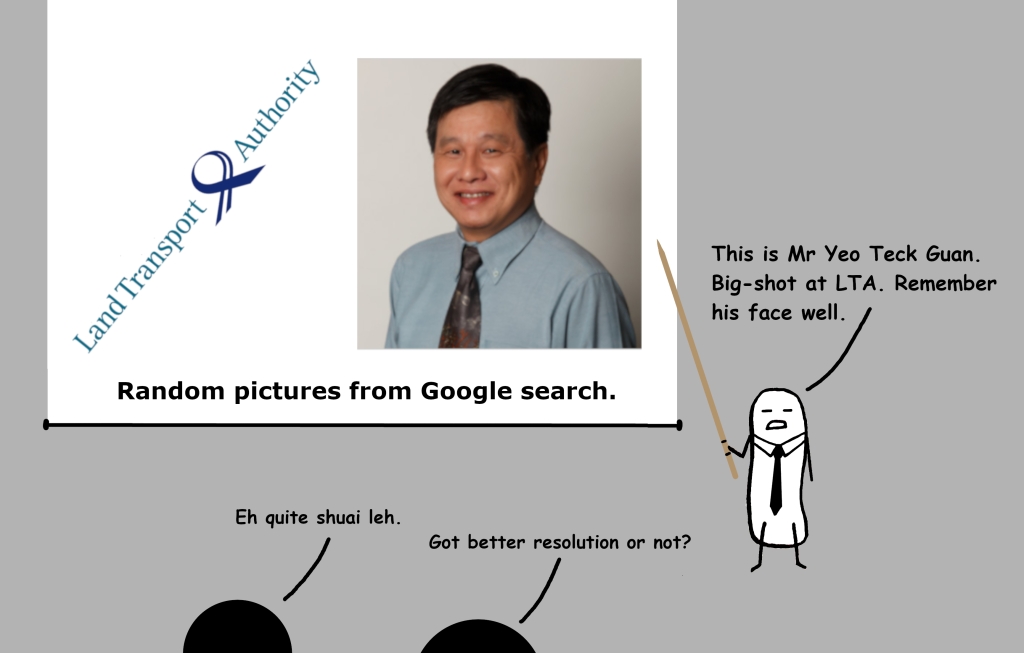I took a short break from studying to quickly wade into the ongoing saga that is the “I-redrew-bus-routes-in-your-neighbourhood-to-save-us-money” saga at Bukit Panjang.
Blah blah – Externalities.
Yes, I know. Public transport can be described as a merit good.
For benefit of doubt, if you don’t already know about externalities and market failures, you can read about these in detail here.
Whenever I hear someone say that, I know that he/she has at least basic grasp of Economics.
Whilst it sounds impressive (actually does it?) to the uninitiated, it honestly feels like a tired concept. It is one of my pet peeves along with liberal use of sentences such as “it is demand and supply you dummy”.
Abstract and de-personalising concepts like these aren’t relevant at all to unhappy residents at Bukit Panjang.
So imagine my mild disappointment when the head of Public Transport division at LTA wrote this to The Straits Times Forum:
We refer to the report (Bukit Panjang to city stretch of DTL incurs $60m subsidy a year, Aug 9).
Whenever a new rail line opens, the ridership for parallel bus services will fall. As a matter of discipline, the Land Transport Authority (LTA) should adjust them so that limited resources can be used to benefit as many commuters as possible.
The current adjustments were planned for when the MRT Downtown Line opened in Bukit Panjang in end-2015, and have been a matter for discussion with grassroots advisers of affected constituencies. The commercial performance of the line is a separate matter altogether.
From the Government’s perspective, fundamentally, revenues from fares, advertising and retail activities of an MRT line can never fully recover the cost of building, equipping and operating the line.
MRT is a merit good, meaning, it will always require large government subsidies funded by taxpayers’ money, and hence the need to exercise fiscal discipline even as we improve services.
LTA recognises the concerns of Bukit Panjang residents, and is discussing various mitigation measures with the advisers.
Yeo Teck Guan, Senior Group Director, Public Transport Land Transport Authority
Some might call this an artful exercise of saying something that meant nothing.
This isn’t entirely true. In fact, reading between the lines and juxtaposing this hot-potato matter alongside Economics know-how might be worth some writing at my end.
Oh, in case you wonder, here is a picture of Mr Yeo himself:

Ok enough introductions. Here are some quick thoughts from me. And they are really quick – because I need to do my homework already!
1. Subsidies are contentious in provision, more so in removal.
I often couldn’t emphasise enough to my students, that this is by far the biggest problem with subsidies, and how they should write this with conviction into their exam essays.
In the ideal situation, the best government policy strikes the perfect balance between ease of introduction and withdrawal, as well as communication.
Sadly, this particular turn of events in “subsidising public transport for Bukit Panjang residents” ended up achieving neither at the moment.
At this point, I wish to be clear that I am not taking sides here. My personal view is that there isn’t an easy decision here and demonising LTA takes that fact away.
2. Cutting back bus frequency might not make sense.
For some residents affected by the complete withdrawal of service 700, they have made suggestions that the solution need not be binary (i.e. full-fledged bus service vs no bus service).
Perhaps if running that service was sucking up too much money for budgetary prudence, why not reduce resources in running that service?
Unfortunately providing a bus service is more than just about buses and bus drivers. Some peripheral (but no less important) resources to consider include:
- Bus interchange commuter spaces and bus parking;
- Bus-stops with up-to-date key information;
- Service scheduling and monitoring;
- Bus fare inspections.
Also, passengers probably took these buses rather than the alternative train or buses, because the benefits outweigh the costs.
Reducing the frequency of the bus service greatly reduce the benefits of commuters, which will reduce cash revenue for the service, which in turn, makes justification of keeping that bus service even tougher.
In the unlikely event that LTA accedes to this request, it may well be on a limited time “trial” (knowing their pattern, but also logical la). But for reasons stated above, the likely outcome may still well be complete withdrawal of the service.
That said, perhaps from LTA’s perspective, delaying the inevitable slightly in such fashion may not be the worst idea. Mr Yeo could perhaps justify the withdrawal when it comes to that by saying “It’s not like we didn’t try”.
‘Nuff said.
3. Train is merit good. Bus isn’t?
What puzzled and disturbed me more was Mr Yeo’s note that “MRT is a merit good”.
Was he implying that buses were less merit-worthy?
He might not. I doubt someone who wanted to make mention of trains ala merit good, would miss the big bus in the room: Public transport as a system has characteristics of merit goods, and not just for trains or buses singly.
Assuming that he meant what he said (and he wasn’t being silly), it might reflect a stand that MRT is the better standard-bearer for public transport.
This is a very old debate in Singapore, and like a fashion trend, it tends to lean hither and thither over the years.
To give some context to the preceding direction, BSEP (Bus Service Enhancement Program) was launched in 2012, and over the next 5 years, LTA partnered with the bus operators to purchase and introduce 1,000 additional public buses in Singapore.
No matter how benignly I try to put it, I have to say that this irony wasn’t lost on me.

Personally, I thought Mr Yeo’s attempt to sound authoritative with the purposeful use of the “merit good” label was a flop:
- Those who do not (want to) understand, may never will;
- Those who do understand, will be like “ok lor”;
- Those who dig deeper may well find this statement shallow and insincere.
4. Heady days of public transport might be over.
It was not long ago when buses rode the wave of renewed vigour in public transport improvements, especially with the BSEP scheme.
And while the fashion trend may have leaned once again more towards fiscal prudence above making public transport awesome, COVID-19 has almost certainly hastened the process by significantly reducing ridership and therefore fare revenue.
With less fats being distributed across the system, the justification in keeping bus services that duplicate other public transport routes become diminished.
As it is, since these affected bus routes were in their current state for a while now (i.e. existed with no amendments for years), I would presume that the axe falling on them:
- Was not conceived overnight;
- Might be repeated in the foreseeable future for other bus routes.
Bottom-line?
Don’t expect good times to last forever as COVID-19 will likely be a prolonged situation, and will probably cause irreversible change to travel behaviour.
5. Fare increases are regressive.
Some feel that the government is fairly ham-fisted when it comes to service provision.
I don’t disagree – though I am not inclined to suggest more subsidies unless I am privy to revenue data nation-wide, which of course I am not.
Apart from raising revenue from non-fare sources (e.g. advertising and retail spaces), which you can imagine would be not be a walk in the park, a “straightforward” way to reduce cost pressures is to increase fares one-time significantly.
After all, almost each year sees increases in fares, albeit by arguably small quantum each round (although never small enough for many).
But there is good reason for the government’s reluctance.
Fare increases tend to be regressive by nature. Because public transport is a necessity for many of us, utilisation of public transport will not differ greatly across the income strata. As a result, fare increases tend to be felt by lower-income families more than the rest of us.
Yes – you could alleviate these negative effects by disbursing cash vouchers or by having other positive discrimination aids, but my point is that raising fares is not something to be taken lightly even if some of us feel it is “fair” that commuters pull their weight.
6. Pareto-inefficient changes.
I actually wanted to put “Some Bukit Panjang residents got shafted real bad this time” as a header, but I decided that it was a bit too rude for that. So I switched to a more presentable, and more importantly, Economics-style header instead.
But there is no denying that this is true. How else should I be describing these changes:
- Removal in entirety of a bus service;
- Re-routing of another to ply a longer route to town, reducing viable choices available to residents going to/from Orchard Road;
- Severe truncation of yet another such that it no longer calls at Bukit Panjang.
I suppose Bukit Panjang residents should pay more in bus fares along with the lot of us, but for fewer buses?
“WHAT RUBBISH” must have been uttered by more residents than one when they saw the news.
From an “Economics” stand-point, the current situation must be Pareto sub-optimal, since the changes made some worse-off (many residents of Bukit Panjang) for the benefit of others (the rest of us who appeared to have been subsidising them in the words of our new Minister of Transport).
When the theory doesn’t agree, and the ground is unhappy too, we surely can’t say that this was a job well done, can we?
Final Thoughts.
Aside from the obvious distress of residents in Bukit Panjang, this is a useful case study for my students (who do not live there, I must say).
As I often emphasise, in any government policy (or just about anything we do), the devil is in the details.
No amount of Economics know-how can fully prepare you for risks and stakeholder management, and it is imperative to appreciate how pluralistic the analysis can often be.
I am only scratching the surface, I hadn’t intended to write as much, and I am sure that I am not rambling. This should say something about the immense difficulties of public transport provisioning.
If you have something to say, or if you live in Bukit Panjang and you would like to say something as well, feel free to leave your comments below.

P.S.: The feature image shown at the top was taken from here. Yes, I am old enough to remember those brief years when we had “smiling” buses, and I am grateful that googling as such turned up some good memories.

Thank you ever so for you blog.Thanks Again. Want more.
LikeLike
Looking forward to reading more. Great article post.
LikeLike